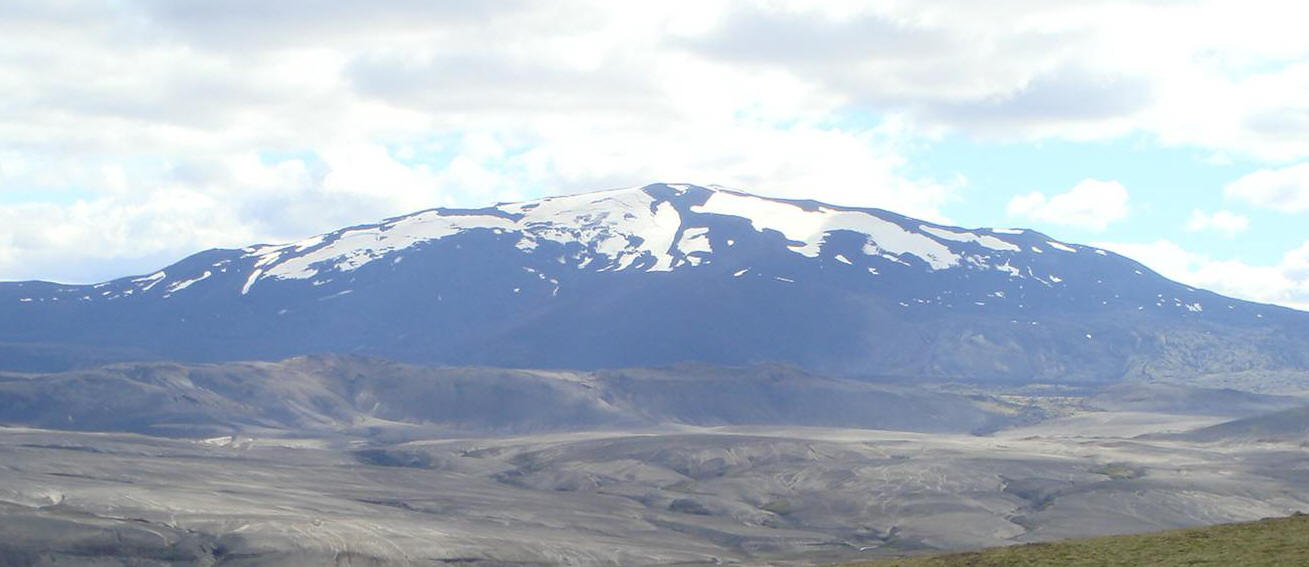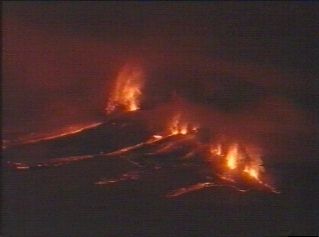|
Assignments
Assignment 1:
On February 26, 2000, Hekla
began erupting, creating a six to seven kilometer long
fissure on the southwest side of the volcano. Six
minutes after the fissure opened, ash was carried 11
kilometers high before being carried away to the north
by the wind. The Science Institute at the University of
Iceland and the Icelandic Meteorological Office detected
only a few earthquakes that gradually increased.
Borehole strain meters detected a decrease in pressure
which allowed the public to be alerted only about
fifteen minutes before the eruption began.
 7 7
This graph shows the
tremors associated with the February 2000 eruption of
Mt. Hekla.
Ash fall was reported as far
as 300 kilometers North of Hekla on the island of
Grimsey (70 kilometers north of Iceland). Several hours
after the eruption started, there was four to five
centimeters of ash 21 kilometers North in the
uninhabited areas in the interior of the island.
By February 27, 2000, lava
flows covered large portions of the South East flank of
the volcano. There were also lava flows north of the
erupting fissure and from three craters near the south
end. The rate of the lava flows varied from several
meters per hour to about one meter per minute.
By February 28, tremor
amplitudes continued to decline and the strength of the
eruption decreased especially north of the volcano.
However, the eruption was not over yet. Two eruption
clouds were seen, and although it was difficult to
observe, an active crater south of the summit produced
three flows down the southern flank.
 8 8
The
eruption continued on February 29, when a volcanic
tremor increased and then activity at the summit
ceased. Meanwhile, activity was increasing at the
southern end of the fissure. Eruption clouds were
produced and three craters produced lava flowing south
west which observers were able to walk on when the flow
stopped.
On March 1, a flight was able
to observe four main vents and three smaller vents that
were producing explosions every four to five minutes.
At the bottom of the large fissure a tumuli, or a lava
fed tube, had developed. The lava streams coming out of
the tumuli and the streams coming from the craters
joined and traveled south in a lava field and grew about
100 meters since February 28th.
The next day, activity
increased on the upper craters. There was constant
steaming from the southwest craters and the steam clouds
rising from the upper craters had increased in size.
That evening, explosions were observed at 30 minute
intervals and lava streams were sighted.
 9 9
A group of scientists were
able to make observations on March 3. They saw that the
lava front was ten meters wide and moving slowly.
Following the lava flow on the west side, the
scientists found the origin, an erupting fissure at the
foot of the volcano. The process of the gas escaping
from the lava produced a blue mist and continued lava
flow was observed.
Observations were difficult on
March 4 and 5 due to bad weather, but by March 6 a
flight was possible. The flight showed that the entire
fissure was steaming, but all of the lava flows had
stopped. The lava stream in the southwest had left
behind an empty channel, but there was no more explosive
activity from the craters.
Minor tremors continued until
the morning of March 8. About 0.11cubed kilometers
which covered about 18 square kilometers.
Eruptive History
information: Smithsonian Global Volcanism
Project 26
Assignment 2:
Many hundreds of years ago, there were two tribes on the
island that is current day Iceland. Because the tribes
lived on a small island, with limited space and
resources, there was constant conflict. Young warriors
were always off fighting one another for small, trivial
amounts of land. Times of peace were celebrated and
cherished with festivals and feasts.
During one
of these times of peace, one of the chiefs’ beautiful
daughters met and fell in love with the bravest of the
warriors in her tribe. The chief’s daughter, Freyja,
whose name meant peace and prosperity, asked her father
for his blessing to marry the warrior. However, before Freyja and the warrior, Hallbjörn
Hafliðason, whose name mean rock
of the sea, could get married, war broke out again.
Freyja
waited everyday for the return of Hallbjörn, looking out
to sea from her window for his boat. However, day
after day passed, and he did not return. Finally
one day, his boat returned, but when the warriors came ashore,
they were not celebrating and Freyja knew something was
very wrong. When Hallbjörn’s body was brought on shore
she mourned for days before she allowed his body to be
prepared for burial at sea. She directed the creation
of the largest funeral ship ever seen on the island to
honor her lost love.
 10 10
When the
ship was pushed out of the harbor and was set on fire,
she watched it drift south along the coast of the
island. Eventually, the burning ship overturned, and
the fires were so hot that they began to melt the
earth. The burning pile became the volcano known as
Hekla, which has the shape of the upside down burning
funeral ship. The volcano created more land to the
south of the island, ending the need for war between the
tribes. The tribes began to live together in peace and
have continued to do so until this day, all because of
the love between and sacrifice of princess and her
warrior.
This story
is not true.
|